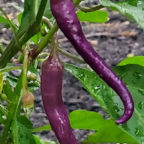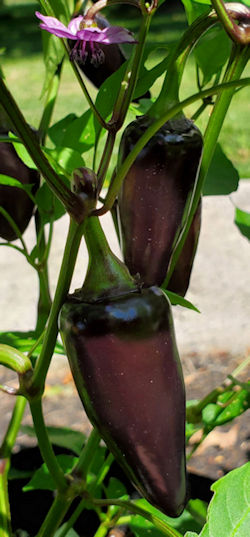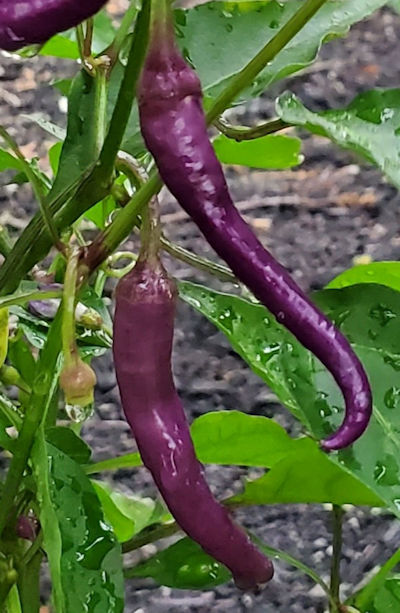Harvesting Peppers – Picking Purple Peppers
Harvesting peppers has started with a bang this Summer 2020 season. I’ve harvested a few in the past couple of weeks, but now the peppers have started growing in earnest. And picking my purple peppers looks to be next on the agenda!
Purple Jalapeno Pepper
Jalapenos are among the easiest peppers to grow (at least for me). Although I am growing two types of jalapenos this year (Purple Jalapeno and Tricked You), it’s the Purple Jalapeno chili pepper that is clearly leading the way.
It’s June 26th and I’ve picked about five jalapenos from the plant, and I think I have at least 10 more peppers waiting to be harvested. The plant is only about 20 inches tall, and it just keeps flowering and setting fruit with abandon. I am seriously glad that I only planted one of these, because it will provide a ton before the fall frosts show up.
I’m growing Purple Jalapeno in a 3-gallon fabric pot. I’m trying to remember to give my peppers a light fertilizer feeding every other week (since they are in containers) but I probably missed a week or two. In other words — no special treatment.
Purple Jalapeno is an open pollinated pepper variety. I can save seeds from one of the peppers, and I’ll get more of the same next year.
Buena Mulata Peppers
Buena Mulata is a cayenne-type chile pepper that, if possible, is even more prolific than Purple Jalapeno! The plant is only about 18 inches tall and I’ve picked about seven chili peppers so far. I easily have 15 more waiting on the plant!
I’ll pick a few more soon (just to keep the peppers coming), but I want to leave some on the plant for a bit to ripen to red. I decided to grow Buena Mulata for the chili peppers, but this variety can very easily double as an ornamental pepper plant.
Just like Purple Jalapeno, Buena Mulata is open-pollinated and is growing in a 3-gallon fabric pot. For that matter, they are actually growing side-by-side. 😀
Picking Purple Peppers
I started picking purple peppers early this month (June). To be honest, the peppers have not been very spicy yet. Why not?
Part of the reason is that it hasn’t been that warm yet here in East Tennessee. While we’ve had one or two days around 90 so far, most of the days have been in the mid 80s. We had a cool April and May, so the peppers haven’t had the opportunity to “chile up” and get spicy. But, as we get more into the hotter days of summer, the peppers will start turning their own heat up.
In addition, as they ripen to their final color (in both cases the color is red), the hotter they become.
I’ll be doing a harvest video soon, with not only these two chile pepper varieties but also some others. I’ll post the link here as soon as I have it posted.
Meanwhile, feel free to wander around the site and enjoy the info (and the peppers). See you soon!
Peppers Planned for 2020
It’s pepper seed time! I decided that I would go the “all seed” route for the 2020 growing season. Although I probably won’t be doing any actual planting of seeds for several more weeks, I have all my seeds ordered. So what’s in store for 2020 in my new location?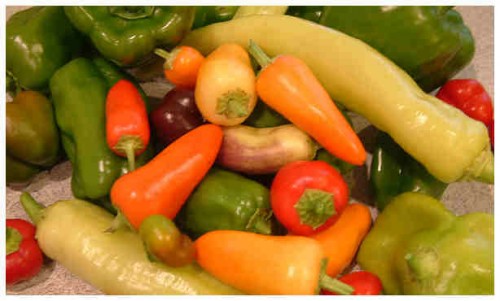
Hot Cha Cha!
I don’t have any super-hot peppers planned for this year, but I do have some hot ones ordered! Here’s the hot pepper seeds on the way:
- Purple Jalapeno:Â Seeing as I am also growing a non-heat jalapeno, I wanted to make my spicy jalapeno a different color so I could tell the two apart.
- Bolivian Rainbow:  I grew this many years ago, then had a hard time finding it again. Success! This is mostly ornamental, but the peppers are definitely edible and quite hot. I love the way these peppers have multiple colors of peppers on the bush all at once.
- Buena Mulata: Another purple pepper. This one is more like a cayenne pepper, and about the same heat.
- Tricked You Jalapeno: This is the no-heat jalapeno. I tried to grow the “Fooled You” a few years back, and I guess this one is the newer version.
- Numex Suave Orange: Supposedly a no-heat habanero. I am not sure that every pepper will be no-heat, so I will be careful when tasting the peppers.
- Aji de Sazonar: Another no-heat pepper, this time more like a serrano in shape. Supposed to be great for drying and grinding into a seasoning powder.
- Tobago Seasoning: A no-heat scotch bonnet pepper. Again, not sure that the heat will be absent from all peppers, but I imagine that the seeds and membranes will be what’s really hot.
A few more of the non-heat hot peppers than is usual for me, bit it will be really interesting to see how “no heat” the no heat peppers will be. Hmmm, now that I have all these listed out, I may hold off on either the Numex Suave Orange or the Tobago Seasoning until next year.
Cool It!
As to the sweet peppers, here’s the run-down:
- Chilly Chilli: Just an ornamental pepper. I seem to recall I tried this a few years back and didn’t have any luck, but I wanted a low-ish growing ornamental pepper that was safe to brush up against (i.e., no hot oils getting on my hands or clothes).
- Yum Yum Mix:Â Mini bell peppers, kind of like the ones I’ve been seeing pop up in the grocery stores lately.
- Sweet Pickle: Another ornamental, a lot like Bolivian Rainbow, but with a slightly larger pepper. This one is like Chilly Chilli, supposed to be safe to brush up against, etc.
- Petit Marseillais: Something like a cross between a bell pepper and a frying pepper, but more like the bell. Supposed to be very sweet.
- Roumanian Sweet: This is a bell pepper. I grew it many years ago, it changes color from a pale greenish-white to purple to orange and then red. It was quite tasty.
All in all, this should be an interesting year for peppers.
Planting Seeds
I have a couple new seed sprouting things I want to trial, so that post will be coming up (actually, probably more like a series of posts).
How Long Do Pepper Plants Live?
How long do pepper plants live, anyway? Are they annuals, perennials or somewhere in between? Can you grow them indoors in the winter? Let’s take a look at the life of a pepper plant.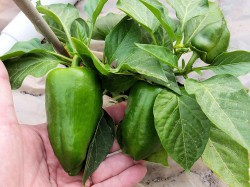
Note: In the years since I have written this post I have had more experiences with keeping pepper plants going — here’s my new post. (Read this one first, though, because it has additional information.)
Pepper Types (Species)
There are five main species of peppers:
- Capsicum annuum:Â Includes bell, sweet and many standard chile peppers like ancho, jalapeno, cayenne and more.
- Capsicum chinense:Â Includes datil, habanero and scotch bonnet peppers.
- Capsicum frutescens:Â Includes tabasco and thai peppers.
- Capsicum pubescens:Â Includes the South American rocoto peppers.
- Capsicum baccatum:Â Includes the aji peppers.
It’s important to know the species, as some are longer-lived than others. All pepper plants can be grown as annuals, but a few species can be perennial, provided they are in very warm, tropical climates.
There’s one pepper that seems to be cross-species, and that is the naga / bhut jolokia pepper. Originally called Capsicum frutescens, DNA testing has found some Capsicum chinense genes as well.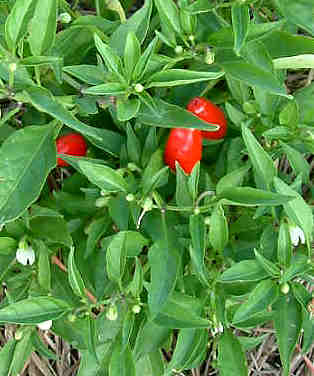
Capsicum Chinense as a Perennial
The Capsicum chinense peppers can live several years, providing they are in a warm climate. In theory, this means you can grow this species in a warm greenhouse as a perennial.
I’ve grown habaneros almost perennially here in South Florida, but I’m afraid that some of our cold snaps have done them in. This year I am trying habaneros and datils in containers, so that I can move them into the house (well, garage at any rate) when the temperatures fall below 45 degrees.
Capsicum Annuum
Your average pepper plant belonging to the species Capsicum annuum is generally grown as an annual. Although I have had some pretty long-lived jalapenos, they eventually get woody and die off.
I’ve never tried pruning a jalapeno, though, to see if I can revitalize it — that’s something I’ll have to try this year.
Although you really can’t grow them as a true perennial, Capsicum annuum can have an extended season. If you’re growing your pepper(s) in a container, you can try moving them indoors when the weather cools down. Just keep in mind that your pepper still needs plenty of sunlight; without sunlight, all the warmth in the world won’t extend your pepper’s life. That may mean a combination of south-facing window along with some supplemental light (grow lights).
Other Pepper Species
The same general rules apply to the other species; they need warmth and plenty of sunlight in order to keep growing. In their native tropical environments, the plants can live multiple years. But even in South Florida, they won’t necessarily live all year around — we do get chilly weather, and even as I write this, I’m expecting freezing temperatures tomorrow night.
So how long do pepper plants live? While they may not be perennial in the sense of living years on end, there are varieties that can grow several years — if you have the right climate.
Additional Reading
You might enjoy these related posts on peppers:
